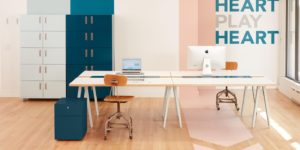Merriam-Webster defines hybrid as “something that is formed by combining two or more things.” Many businesses are finding themselves testing and adopting a hybrid schedule to accommodate alternating staff scheduled. As a result, both the way the office is configured and how space is allocated is being revisited. Private offices and large conference rooms that are mostly unused might be repurposed as drop-in workstations and large open spaces might be more useful divided into smaller, flexible work areas. Here are five ideas to think about when designing a hybrid-friendly office.

Make physical and psychological safety a priority
Creating individual areas and small collaborative areas, with furniture that can be moved as needed, makes it easy for people to choose the best work spot on any given day.
Create a sense of belonging
Spaces that promote different sized conversation and collaboration are inviting and help establish a sense of belonging. When staff is rotating in and out of the office, consider lockable colorful storage and lockers to keep documents and personal belongings. Research shows that a strong feeling of connection and community in the workplace supports productivity, engagement, and innovation.
Promote productivity
With a hybrid work schedule think about creating small work spaces for solo and small groups, for both in-person and virtual activity. Spaces that allow everyone to hear and be seen and heard promote a range of activity. Quality cameras, acoustical and visual partitions, and good lighting are recommended.

Ensure comfort
User comfort takes on a variety of shapes and forms. For some, spatial comfort matters, for others they care about comfort with technology, or having access to the right technology and tools.
Make it easy to reconfigure
Who doesn’t love choices? Having a choice of when, where, and how to work or gather is empowering. It also encourages participation and can boost energy and engagement. Furniture, like seating and tables that can be easily reoriented, and accessories like rolling storage, marker boards, and mobile space dividers are perfect in flexible work spaces.
